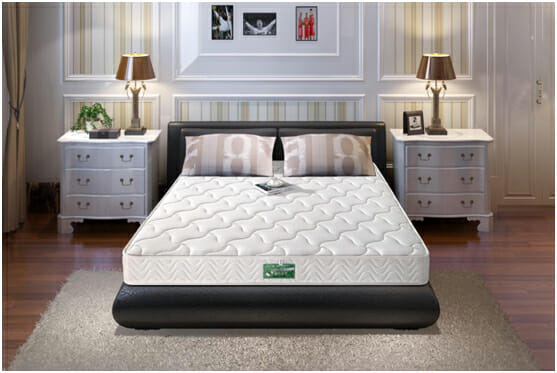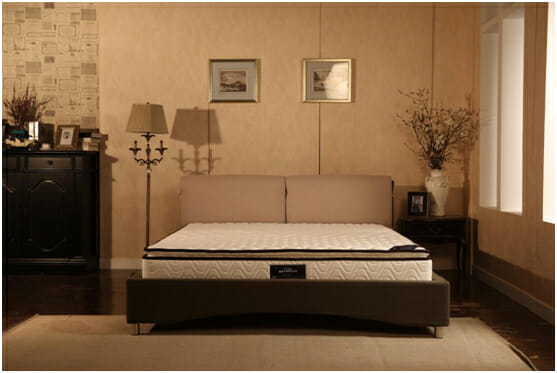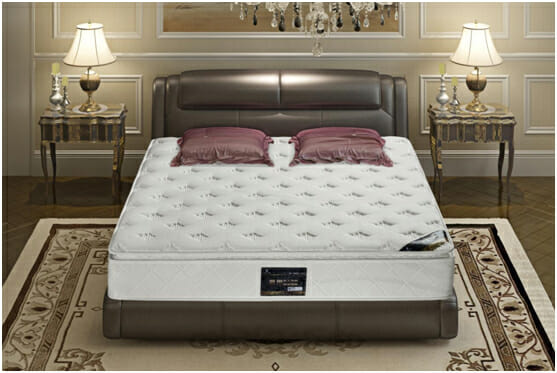We spend a third of our lives asleep, so investing in a quality mattress is essential. Check out this expert advice to help you choose a good mattress.
If you’re not sleeping as well as you once did or are waking up with aches and pains, it’s probably time to replace your mattress. Actually choosing one from the numerous designs out there, however, is another matter. Will you go for firm or soft? Synthetic or wool-filled? Pocket-sprung or memory foam? Before you dash out and make a hasty purchase, read what the experts have to say.
Professional advice from:
Adam Black, founder of Button & Sprung
Jamie King, bed buyer at Fishpools
Charlie Marshall, founder of Loaf

Is it time to replace your mattress? The general consensus is that you should replace your mattress every seven to eight years.
‘Even if it doesn’t show many outward signs of wear and tear, it may not be giving you the support and comfort you need to get a good night’s sleep,’ says Jamie King. ‘A sagging area in the middle of your bed is a sure sign a new mattress is needed. Other indicators include lumps and any creaking noises coming from the mattress during the night.’

Know your mattress types
There are four main types of mattress on the market, although others, such as gel mattresses, are also available. Understand the terminology before you start shopping.
Open-spring mattresses offer support from springs made from one long piece of steel wire. This is the most common mattress type and typically the most affordable choice, but it doesn’t always offer the best support for daily use.
Pocket-spring mattresses, which have springs individually encased inside fabric pockets, can be more supportive. The choice of filling around the springs inside these and open-spring designs – whether wool, synthetic or another material – will also make a difference to the support the mattress offers.
Memory foam mattresses have no springs. They feel quite different to sprung mattresses and mould to the shape of your body.
Latex has a resilient feel and is good for allergy sufferers. It’s naturally elastic, so offers a good distribution of pressure along your body. Generally, the thicker the mattress, the better the support.

Try before you buy
Test a range of beds before making your final decision. ‘It’s really down to what’s right for you,’ says Charlie Marshall. ‘When hunting for your perfect mattress, settle in as you would at home, kick off your shoes and take a good book with you.’
Lie down for around 15 minutes, adopting your normal sleeping position. If you share a bed, make sure you’re both there to try it.
Sims Hilditch
Firm, medium or soft?
Sprung mattresses generally come in a choice of firm, medium or soft support. ‘As a rule of thumb, the heavier you are, the firmer your mattress should be to balance out body weight,’ advises Adam Black. ‘The lighter a person, the softer and more yielding a mattress should be.’ Be aware that firmness ratings differ from one manufacturer to another.
82mmphotography
Best for backs
A mattress that is either too hard or too soft can result in back pain, so take the time to find one that’s right for you. ‘A simple way to gauge this is to place your hand under the small of your back – if there’s a gap, then it suggests the mattress is too firm. If you struggle to get your hand underneath, it’s probably too soft,’ explains Jamie King.
Jino Design Ltd
When it comes to a bad back, there’s no single solution as no two people are the same. ‘While many “orthopaedic” mattresses do tend to be very firm, this doesn’t necessarily mean that a hard mattress is right for you,’ explains Jamie King. ‘Instead, look for a model that will offer support for your back as well as high levels of comfort.’ (Read on for more on support.)
Domus Nova
Invest for the best
Buy the most comfortable mattress you can afford. As mattresses increase in price, they tend to have a higher spring count and better-quality fillings. The higher the number of springs and the more luxurious the fillings, the more the mattress will contour to your body, so the less interrupted and more comfortable your sleep should be.
Park Grove Design
The advantages of pocket springs
Arguably, a pocket-sprung mattress provides the most comfortable night’s sleep. ‘In a pocket-sprung mattress, the springs are not linked together, allowing them to move individually and adjust effectively to the contours of your body,’ explains Adam Black. ‘They are made from higher-quality materials and can be purchased in different tensions to offer an appropriate level of support.’
Button & Sprung
What’s in a filling?
Mattress fillings work in tandem with springs to create a balance of comfort and support. As a general rule, the more fillings a mattress contains, and the higher the quality of those fillings, the more sumptuous it will feel.
‘In our experience, synthetic fillings tend not to last as well as natural fillings and have inferior qualities,’ says Adam Black. ‘We fill our mattresses with a combination of British-grown hemp and Herdwick wool from Yorkshire. Wool has anti-microbial, anti-bacterial and anti-fungal qualities, making it ideal for asthma or allergy sufferers. It’s also naturally elastic, which means it keeps its structure, so your mattress keeps its comfort.’
Rosangela Photography
Sleeping in harmony
If your partner is heavier or lighter than you, the solution may be a combination mattress with different spring tensions on either side. ‘The vast majority of people sleep on the same side of the bed, so it’s worth the investment,’ advises Adam Black.
Alternatively, look out for zip and link mattresses, which are essentially two mattresses of different tensions zipped together.

